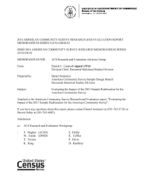
An official website of the United States government
Here’s how you know
Official websites use .gov
A .gov website belongs to an official government organization in the United States.
Secure .gov websites use HTTPS
A lock (
) or https:// means you’ve safely connected to the .gov website. Share sensitive information only on official, secure websites.
-
//
- Census.gov /
- Census Working Papers /
- Evaluating the Impact of the 2011 Sample Reallocation for the ACS
Evaluating the Impact of the 2011 Sample Reallocation for the American Community Survey
Evaluating the Impact of the 2011 Sample Reallocation for the American Community Survey
This document presents an evaluation performed to assess the impact of the 2011 Sample Reallocation for the American Community Survey (ACS) and Puerto Rico Community Survey (PRCS). In 2010 research was conducted to investigate the need to reallocate (or redistribute) the ACS and PRCS sample. Making this determination was a starting point for this research. If in fact there need to reallocate, we would develop methodology to modify the ACS sample design in a way that would allow for a more equitable distribution of sample. The goal being to minimize differences in estimate reliability across areas (primarily census tracts) while maintaining the robust estimates for the larger geographies.
As a replacement for the Census Long Form questions, the ACS is tasked with providing reliable estimates for all levels of geography. From the sample design perspective, the chief mechanism to control reliability is the amount of sample that is allocated to these areas. The sample design is constrained by an annual sample size that is generally unchanged from year to year, instead of a potentially more optimal design whereby the sampling rate is held constant.
Since the inception of the survey, the sample design has been based largely on the sample design for the Census 2000 Long Form. The AC S design used seven sampling strata based on census tract and functioning governmental unit size categories. The design also further stratifies using housing unit response rates. Five of the sampling strata were based on size categories. Two of these strata were split into high and not high housing unit response rate strata, resulting in the seven strata. The goals of the initial research were to 1) further refine these sampling strata, since they cont in a large proportion of all addresses on the sampling frame, and utilize more size categories which would provide more control over the sample allocation for these areas, and 2) provide an overall increase to the sampling rates in the smallest geographic areas.
Others in Series
Working Paper
Working Paper
Working Paper
Share
Some content on this site is available in several different electronic formats. Some of the files may require a plug-in or additional software to view.
 Yes
Yes
 No
NoComments or suggestions?


Top

